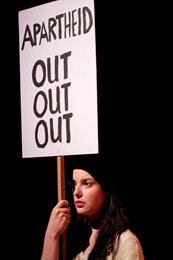Strike! is an ambitious dramatic rendering of the anti-apartheid strike by eleven Dunnes Stores workers which began in July of 1984 and ended in victory over two and a half years later. The playwright, Tracy Ryan, and producer Helen Ryan last worked together on 'Cracked Eggs' in reverse capacities at the New Theatre and have credits between them which include acting and writing novels and screenplays. The production, in conjunction with the UCD School of English, Drama and Film, showcases recent or current students of both its BA and MA programmes.
The play faces the primary task of docu-drama – how to weave the back story and relevant details into the fabric of drama without becoming tedious or pedantic. For the most part Strike! achieves a happy balance in pursuit of this goal. The narrative is provided by dialogue, but also by video and photos of the strike and related events. Images of the remarkable anti-apartheid posters of the era are particularly effective. The script, while avoiding political harangue, could have been edited more tightly and delivered at a faster pace. A work which was quite visibly engaging for the audience could have, with a bit more edge, electrified them.
 The plot, after all, was there for the taking. And what a plot it is. Strike! is part of a continuum in contemporary Irish theatre with contributions from Tom Kilroy’s controversial representation of the Dublin Lockout of 1913 in Talbot’s Box to the stage version of James Plunkett’s Strumpet City, set in the same place and time, Friel’s The Freedom of the City and Frank McGuinness’ Carthaginians (both dealing with Bloody Sunday). The dynamic of Strike! is most reminiscent of McGuinness’ earlier strike drama, The Factory Girls, with its female working-class cast. Ryan’s subject matter is much more dazzling. It’s hard to go wrong when the peripheral players include Desmond Tutu, Nelson Mandela and Jesse Jackson, to say nothing of the interactions of the Dunne Empire, government ministers, the hierarchy and a gaggle of feisty Dublin shop assistants. Strike!, if only towards the end, shows up the venality and power mongering of the trade unions, as well as all the other stakeholders in the dispute. Ryan captures the reality of that era for women and the young in the workplace – an atmosphere of sexist attitudes toward workers whose jobs were insecure and without many basic rights or benefits.
The plot, after all, was there for the taking. And what a plot it is. Strike! is part of a continuum in contemporary Irish theatre with contributions from Tom Kilroy’s controversial representation of the Dublin Lockout of 1913 in Talbot’s Box to the stage version of James Plunkett’s Strumpet City, set in the same place and time, Friel’s The Freedom of the City and Frank McGuinness’ Carthaginians (both dealing with Bloody Sunday). The dynamic of Strike! is most reminiscent of McGuinness’ earlier strike drama, The Factory Girls, with its female working-class cast. Ryan’s subject matter is much more dazzling. It’s hard to go wrong when the peripheral players include Desmond Tutu, Nelson Mandela and Jesse Jackson, to say nothing of the interactions of the Dunne Empire, government ministers, the hierarchy and a gaggle of feisty Dublin shop assistants. Strike!, if only towards the end, shows up the venality and power mongering of the trade unions, as well as all the other stakeholders in the dispute. Ryan captures the reality of that era for women and the young in the workplace – an atmosphere of sexist attitudes toward workers whose jobs were insecure and without many basic rights or benefits.
The choreography, by Trina McCann of Cois Céim, impresses. Her large and energetic cast is kept carefully on the mark and effortlessly mobile on a relatively small stage, aided by the simplicity and flexibility of the set. Having actors propel themselves on and off stage on wheeled black office chairs was an expeditious idea. Light and portable plastic milk crates become the strikers’ eventual soap boxes; a silhouetted line of shop girls dance with swinging shopping baskets aloft. Clancy Flynn’s lighting keeps the flux of bodies and visuals under control, while there is less consistency apparent in Lina Altiparmaki’s costume choices, some of which would simply not have been chosen even if they had existed in 1984. Despite the cast of twenty, the play calls for several double or treble roles. Works such as Ryan’s provide an invaluable opportunity for young actors to gain ensemble experience.
 The idiosyncratic programme does not name roles, nor assign actors to same. The “strikers” are credited in a group listing (although with individual head shots and biographies), with “the rest of the cast” similarly credited on a facing page. Perhaps this decision was an act of solidarity, but it is, finally, confusing. Audience members old enough to remember the strike might be able to identify most of the unnamed roles, even that of a well-known media interviewer. Other characters are referred to generically as “Minister” or “Father”. The Dunnes, although clearly identifiable, are not named either. John Carey and Ciara McGuiness in these brother and sister roles provide a calibrated caricature. Special mention among the actors from the strikers’ column must go to Aisling Burke, Catriona Lynch, and Melissa Nolan.
The idiosyncratic programme does not name roles, nor assign actors to same. The “strikers” are credited in a group listing (although with individual head shots and biographies), with “the rest of the cast” similarly credited on a facing page. Perhaps this decision was an act of solidarity, but it is, finally, confusing. Audience members old enough to remember the strike might be able to identify most of the unnamed roles, even that of a well-known media interviewer. Other characters are referred to generically as “Minister” or “Father”. The Dunnes, although clearly identifiable, are not named either. John Carey and Ciara McGuiness in these brother and sister roles provide a calibrated caricature. Special mention among the actors from the strikers’ column must go to Aisling Burke, Catriona Lynch, and Melissa Nolan.
Uché Gabriel Akujobi, playing Nimrod Sejake (who is named in the script), was an exiled black South African activist and union organiser who picketed daily and returned to his homeland after the collapse of apartheid. His story is only one which was irrevocably changed by ten young women and one, later two, young men, who began as political naifs, and became radicalized largely as a result of shabby treatment at the hands of their Irish employer. The actors achieve this transformation while maintaining historical and artistic integrity. And integrity is what Strike! is all about.
Christina Hunt Mahony, who directed the Center for Irish Studies at the Catholic University of America, now lectures in Trinity College. She is the editor of Out of History: Essays on the Writings of Sebastian Barry.